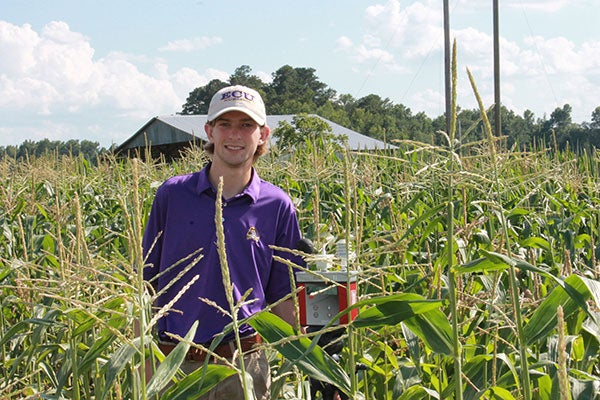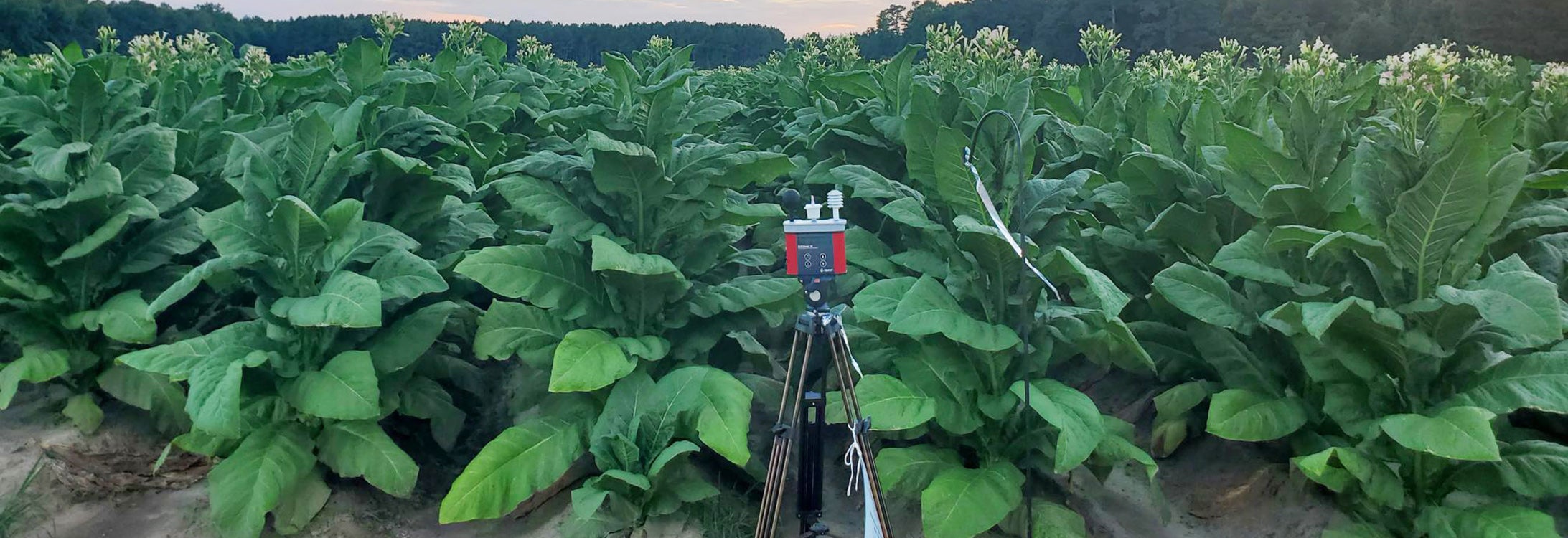HEAT RESEARCH
Nursing researchers focus on heat stress in farm workers
Nurses take vital signs at a visit to the doctor. They are the constant at the hospital bedside, caring for our loved ones and answering endless questions. And they are the ones who tend to fevered kindergarteners in our schools.
But one East Carolina University nursing professor is upending the popular conception of what a nurse does, and can be, by plowing new fields of research into how climate change affects the estimated 150,000 farmworkers in North Carolina.
Real world research

Dr. Elizabeth Mizelle. (ECU photo by Ty Huff)
Dr. Liz Mizelle, a professor of nursing, is no stranger to the violence of climate change. Her hometown of Windsor, North Carolina, sits about three feet above sea level and has experienced two 1,000-year flooding events in recent years. Her house was nearly flooded during Hurricane Matthew in 2016.
Farm worker safety has been a research passion for Mizelle for years, since before she started her doctoral program at ECU.
“If you compare farmworkers to other workers, they’re 35 times more likely to die from heat, and Latinos in agriculture are three times more likely than other non-Latinos,” Mizelle said. “There are a lot of factors, but North Carolina is very hot and humid and they work very long hours.”
Mizelle’s current study focused on row crops, the tall ones commonly grown by North Carolina farmers: tobacco and sweet corn, both of which still require manual labor instead of machines. Sweet corn, the kind that we find on backyard picnic plates, make up about only 1% of corn harvests in the U.S. and must be picked by hand and tobacco leaves are stripped from stalks by hand, too.
Tobacco is particularly tough to work in. Long sleeves and pants are required because tobacco can be caustic and damage exposed skin, but long sleeves and pants make miserably hot days more miserable.
Mizelle had a hunch about tall row crops. Her extended family plants fields in Bertie County with all kinds of crops so she knows firsthand that winds can temporarily ease the sweltering summer temperatures but don’t reach the center of corn and tobacco fields. Work in a summer field of melons is brutal, but there is at least a chance of a breeze to bring some relief.

Mizelle’s daughter with an ear of corn grown in the field planted by Edwards.(Contributed photo)
Also, tall row crops transpire (kind of like plants sweating) which she theorized can raise humidity levels in a field of corn.
“You can talk to any farmer and they’ll tell you it does feel hot in the corn and tobacco, significantly different,” Mizelle said.
Evaluating the heat load on a body is complicated. Occupational health professionals rely on wet bulb readings, an algorithm that accounts for temperature, humidity, latitude and cloud cover.
Mizelle’s research proposal was fairly simple: set up monitors outside of a row crop and in the center of the field to see what difference, if any, there actually is. Perceptions from research participants are helpful, but science requires numbers and facts.
For the past few years Mizelle has enlisted Honors College students, who are required to participate in an honors research project prior to graduation, to test farmers’ hydration levels and study heat loads on farmland. But this year Ryan Edwards, one of her research students, aimed for extra credit by planting a full acre of sweet corn on his family’s farm to use as a dirt and plants laboratory.
Student development
Noel Lanier, a junior nursing student from Bunnlevel in Harnett County, knew she wanted to work in health care and started as an exercise physiology major. But the tragedy of losing two of her grandparents in quick succession between her first and second semesters at ECU made clear the change her life should take.
“I experienced hospice nursing and how they cared for my grandma, and how the ICU nurses cared for my granddaddy. The compassion and love — they treated him like he mattered, that he was a human being,” Lanier remembered. “So, I decided to change my major to nursing and I absolutely love it. This is where I was meant to be.”

Noel Lanier in a tobacco field used in their study. (Contributed photo)
Lanier loves working with kids, but her true passion is women’s health and she hopes to be a nurse practitioner following graduate school. She credits her certified nursing assistant qualification and job at ECU Health Medical Center in Greenville with giving her an understanding of how nurses impact people — be it in a behavioral health unit in a hospital or with a clipboard in hand in the middle of a tobacco field.
“It’s been helpful to practice my skills. I went to clinical with some of my peers and they were scared to talk to patients and I said ‘Y’all, I promise it’s OK,’” Lanier said. “But I was the same way when I first started working in the hospital.”
Lanier’s student partner in the research project, Edwards, has deep roots in Chadbourn, a small town between Fayetteville and Wilmington. Edwards said spending time with his grandmother as a young boy got him interested in nursing. He tagged along with her to medical appointments and developed an interest in what the nurses were doing.
When he was accepted into the Honors College he was given a list of projects that he might want to join for his research requirement. When he saw Mizelle’s investigation of heat stress on farmworkers, it was a no-brainer.
“I am a farmworker. When I was growing up, me and my dad, we grew row crops like corn and soybeans, so not too much manual labor, but you’re out there in the heat. One year we did grow tobacco, which showed me the manual labor aspect of farming,” Edwards said.
Addressing climate change in NC
The research team’s initial data review is showing there isn’t a huge difference between the temperature readings outside of the stands of corn and tobacco, but the devil is in the details. Temperature is only one factor when analyzing climatological stressors on the human body. Humidity — everyone who has spent any time in eastern North Carolina in the summer knows — is the X factor that can turn an uncomfortably warm day into an unbearable ordeal.
One of the confounding aspects of climate change is its unpredictability, which brings wild swings in temperature and rainfall leading to drought and floods, along with heatwaves and extreme cold events. June was no exception, with abnormally low temperatures at the beginning of the month, that proved the climate change rule that the rule books have to be thrown out the window.
“By the end of June we started seeing some temperature spikes that were technically not safe, that people shouldn’t be working in,” Lanier said.

Ryan Edwards with a wet bulb globe device that measured atmospheric conditions in a field of corn planted on his family’s land. (Contributed photo)
Despite the anomaly, Mizelle and her students are confident that they’ll have enough data to verify her theory about heat loads inside fields of row crops.
“What we’re probably going to do is look at what the averages normally are for June in North Carolina in that area and put those in our paper to let people understand that it was not a typical June,” Edwards said.
Mizelle said that most outdoor workers — those on farms and in construction trades — understand the acute signs of heat distress like dizziness and dehydration, but it’s the chronic effects that build over time. In recent years researchers have begun to notice incidences of chronic diseases, particularly chronic kidney disease, in otherwise healthy populations in the equatorial belt.
Young men are especially prone to the effects of heat stress because they often work outdoors in demanding occupations. Mizelle said more research is needed but it appears to be a result of chronic dehydration of healthy adults working in increasingly difficult levels of heat and humidity.
“As tropical climates expand into our subtropical and temperate ones, diseases could become more common,” Mizelle said.
One way that farmworkers might be able to mitigate heat stress injuries is simply drinking enough water to cool their bodies and keep their internal organs functioning properly. During a meeting with a regional farmworker health outreach organization, Mizelle suggested they provide backpack-style water bladders to the workers to cut down on time walking back and forth through the crop rows to get a sip of water during the day.
In a previous study, one of Mizelle’s student researchers measured the workers’ urine to test hydration levels. The findings were stunning, but not surprising — half were dehydrated before even beginning work and everyone was dehydrated at the end of the day.
Testing is yet to be done on the local workers provided the water bladders, but research from another study in El Salvador where farmworkers were provided water bladder hydration systems is promising.
“Their productivity increased, their water intake increased and self-reported symptoms of heat-related illness decreased,” Mizelle said, which suggests that a relatively inexpensive piece of equipment could make farm work better and safer.
Edwards hopes that the team’s research will bring real change for those working in corn and tobacco that he is so familiar with.
“The best way to stop heat-related illnesses is prevention,” Edwards said. But Mizelle cautioned that finding a balance between government mandated work-rest rules and preventative measures, some as simple as body worn water bladders, is probably the most reasonable way forward.
“We have to meet in the middle. What can we do to keep outdoor workers safe, but also keep them productive in their jobs?” Mizelle said.
Mizelle’s work to help prevent heat injuries in workers extends outside of North Carolina. She and colleagues from Villanova and Emory universities have trained nursing students in Georgia in first aid for heat-related illnesses.
Climate change is a reality that is affecting North Carolinians today, not at some abstract point in the future, and Mizelle hopes that she and her nursing colleagues can bring the public’s attention to the realities of new climate normal.
“We definitely have to make climate change applicable to our patients and communities,” she said. “People in North Carolina aren’t as interested in the polar bears in the Arctic as being able to swim in a river in their backyard without getting a toxic algae bloom contact or if they can’t go outside during the day because of the extreme heat.
“We learned in the pandemic that farmers are critical to our society, so we’ve got to keep them healthy. That might sound a little selfish but they are such a critical component to our everyday life.”
